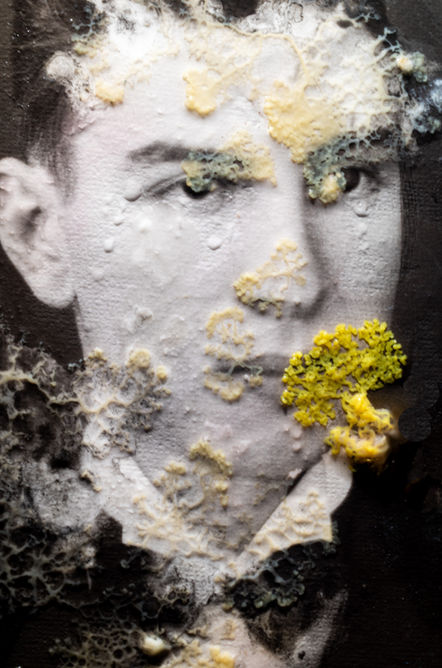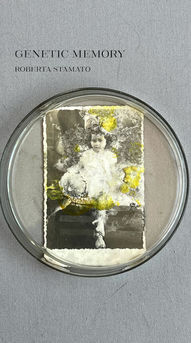
Genetic Memory
What do we carry down from our ancestors?
Original family archive portraits with Physarium Polycephalum
interference. Photos and vídeos taken during the process.
Genetic memory
What do we carry down from our ancestors?
Untold stories about my family led me to get my DNA analysed. As 39% of my
genes are Italian, I went to the south of Italy, where my ancestors were from,
until they immigrated to Brazil. I wanted to experience and feel the places that
they had passed through and soon their memories became tangible; a jumble of
interconnected roots in different spatial and temporal dimensions, memories that
have contributed to making me the person I am today.
The genetic theory. defends the idea that certain memories, intelligence or
behaviour, can be inherited through genetic or epigenetic mechanisms. It involves
the storage and transmission of information in an organism's DNA.
I chose to use the Physarium Polycephalum organism, also known as the Blob, as
an agent of interference and transformation of photo portraits of my ancestors,
to bring new life to them. Moreover, this practically immortal creature has no
brain, yet it can learn and share its knowledge with other Blobs. This raises the
following question:
If the brainless, unicellular Blob can store and transmit knowledge could we also carry over memories, intelligence and behaviour in our cells?
Original family archive portraits with Physarium Polycephalum
interference (unique pieces) and photos taken during the process.
The organisms used and dried on the photos, if they are hydrated and
have a favorable environment, can live again.
The videos are an illustration of the project process.
The first phase of the work was carried out during the academic year at NABA under the supervision of Francesco Zanot.
© Roberta Stamato
Memória genética
O que herdamos de nossos antepassados?
Histórias não contadas sobre minha família me levaram a fazer uma análise do meu DNA. Como 39% de meus genes são italianos, fui para o sul da Itália, de onde eram meus ancestrais, até imigrarem para o Brasil. Eu queria conhecer e sentir os lugares pelos quais eles haviam passado e logo suas memórias se tornaram tangíveis; um emaranhado de de raízes interconectadas em diferentes dimensões espaciais e temporais, memórias que contribuíram para que eu me tornasse a pessoa que sou hoje.
A teoria genética defende a ideia de que certas memórias, inteligência ou
comportamento, podem ser herdados por meio de mecanismos genéticos ou epigenéticos. Ela envolve o armazenamento e a transmissão de informações no DNA de um organismo.
Optei por usar o organismo Physarium Polycephalum, também conhecido como Blob, como um agente de interferência e transformação de retratos fotográficos de meus antepassados, para dar nova vida a eles. Além disso, essa criatura praticamente imortal não tem cérebro, mas pode aprender e compartilhar seu conhecimento com outros Blobs. Isso levanta a
seguinte questão:
Se o Blob unicelular e sem cérebro pode armazenar e transmitir conhecimento, será que nós também podemos carregar memórias, inteligência e comportamentos em nossas células?
Retratos originais de arquivo de família com interferência da Physarium Polycephalum (peças únicas) e fotos tiradas durante o processo.
Os organismos usados e secos nas fotos, se estiverem hidratados e
e tiverem um ambiente favorável, podem viver novamente.
Os vídeos são uma ilustração do processo do projeto.
A primeira fase do trabalho foi realizada durante o ano acadêmico na NABA sob a supervisão de Francesco Zanot.
© Roberta Stamato
Project Gallery
























